In 1947 Chevrolet introduced their new “Advance Design” pickup truck as their first modernized post-war design. Between the years of ’47 and ’55 continual improvements occurred with each successive year. Three different capacity trucks were available during these years including a half-ton, three quarter-ton and a one-ton version like this 1950 example, located in Sweet Grass, Montana and available here on eBay for a BIN price of $6,995.
Any way you cut it, pickup trucks have evolved tremendously over the last 70 years; actually, significantly alone in the last 25 years. But since this 1950 Advance Design example rolled off of a Chevrolet truck assembly plant the changes between it and a 2020 Chevrolet Silverado would be unrecognizable. Pickups in this era were truly no frills, utility vehicles and their popularity in modern times has certainly grown.
The description of this “3800” (the official Chevrolet designation for a one-ton model) is light but we are told that it does run. Under the hood is a 216 CI, inline six-cylinder engine which generated about 92 HP. The interesting thing about this version of the Chevy “Stovebolt” is that it did not use a pressurized lubrication system. It relied on a combination of an oil trough and a sprayer that squirted oil at the lower end rotating assembly. While this doesn’t seem like a very appropriate system for an engine that would be stressed as truck engines in those days were, it obviously worked. As expected, you manually row the gears in this pickup.
The interior of this pickup does not look like a place where you would want to spend a lot of time. You can forget about creature comforts like AC, automatic transmission, reclining seats, a sound system, power brakes/steering and windows, this is as rudimentary as it gets. While there wasn’t much of an accommodating passenger compartment to start with when new, the seats look like they’re done (though there is a piece of plywood for bottom support), disintegrated door cards and no rubber pedal pads for the brake and clutch pedals, the floor looks sound however.
The body of this pickup does have rust and I’m not referencing the obvious surface appearance. There is panel perforation in the lower part of the fenders and doors, pretty much where you would expect to find it. It doesn’t look excessive but it will warrant further inspection as there is probably more lurking elsewhere. One obvious place to look is in the support structure for the bed – unfortunately there are no images provided. I imagine the bed is made of wood and I’d like to know about its condition.
Chevrolet’s cross-town rival’s 1950 pickups are really popular now, quite collectible and I see no reason why this Chevy wouldn’t be as much of a draw too though I wonder if the fact that it is a one-ton model would be of less interest than a lighter capacity version. Why? This is a heavy-duty truck and I would imagine that it drives and feels very much like a heavy-duty truck. So, what do you think, leave it as is with its patina (yes, I know there are readers who don’t appreciate the look or the “P” word) or try a restoration? Better yet, what do you think about a resto-mod treatment?
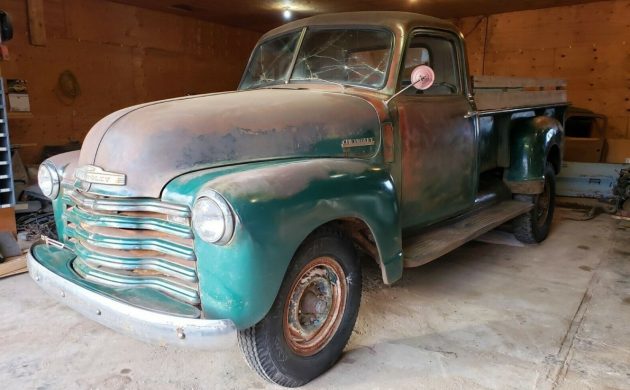
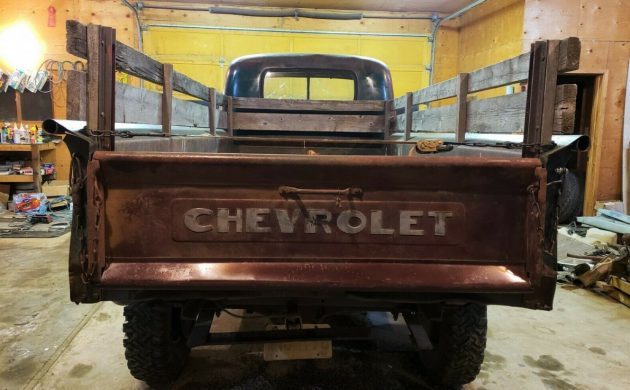
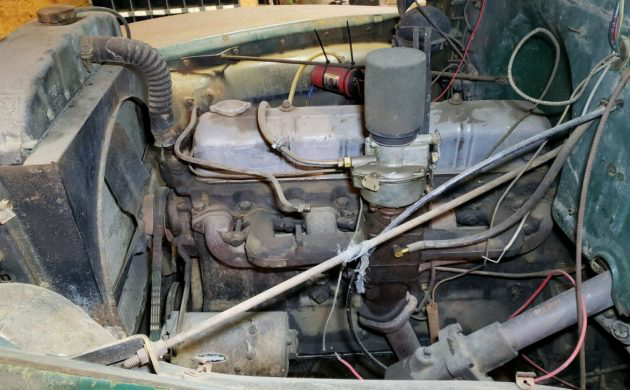
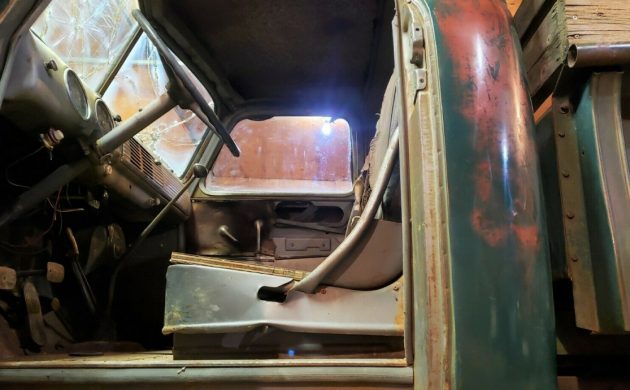
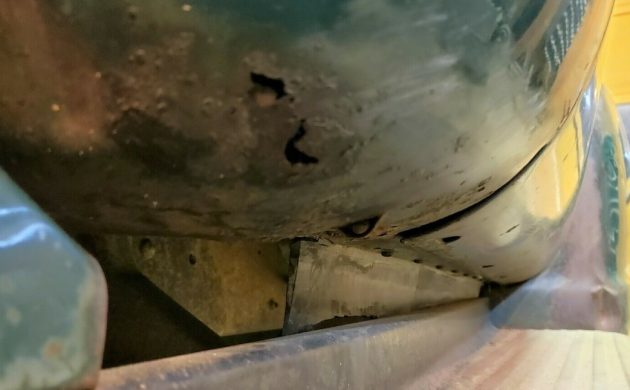



Another very nice looking potential restoration project truck from Sweetwater! Cmon, Superlotto!,!
Notice how every time you see an early 1950s Chevy truck it’s painted this color green?
Must have been popular new. Two of my uncles had the same green on their early 1950s Chevrolet sedans.
“No profanity” clearly stated in the site rules yet the second word in the heading is the obscene “P” word. One tonner should have a 9-foot body I believe. As noted above, that dark green has to be the most common Chevy truck color of all time. A somewhat rare truck with high potential for a high quality correct restoration.
Put a red bow on the hood and a Christmas tree in the bed, and you got yourself a Hallmark movie.
It just needs some nice big bumper guards (over riders?) on it to be perfect.
Looks like a sound truck to restore. I would imagine it rides like a buckboard and tops out somewhere 50-55 mph so that will limit use if kept stock. Probably destined to be a resto-mod, it seems to have good bones. Of course, it has to be painted. That’s the only “P” that should adorn this classic’s skin.
Funny that all the truck builders of the era seemed to gravitate towards this dark green color. Trucks like this were common out west. They were often the grain hauler, the ‘gopher’ truck and sometimes even the family car. Simple to fix and didn’t require that very often. The 216 was a good engine. There were a lot of them came through our shop, even in the 70s. I was mildly surprised to see that the majority of those engines were original…
Back in the early Seventies in the Colorado mountains west of the divide, these ( 1/2 ton etc) were everywhere. They were the “Mountainman” ‘s ride of choice. I had a few. ( Of course I was more of a Mountainboy) I’m partial to the five window ( we used to call then 3 window) cab with the corner windows.
I imagine the 1 ton is a bear to drive. I can remember kickin the optional heater with my gas pedal foot trying (lol) to get more heat out of it. Lol. Kids!
Every time I see one I’m seventeen again!
They were all over the western prairies and foothills too. They were terrible to heat unless they had a decent thermostat. I remember hauling grain in the winter and I always welcomed a good thermostat. Those old Babbitt Pounders held up just fine as long as you ran 10W oil, something unheard of today…
“The cab corners are excellent with only very minor rust blisters”. Someone needs to explain to the seller that cab corners with rust holes are not excellent. The mention of a mysterious hole in the passenger side floor but no picture of it? Sounds like there is something to hide.
This trucks a 1950, the cab corners are better than my 2014. I would agree that is excellent. And what on earth could there to be to hide on a 1950 Chevy truck? This isn’t a very complex machine. You’re delusional pal.
Apparently you haven’t learned how to wash under your POS 2014 to help prevent rust. Not my problem, and has nothing to do with this truck. Rust holes, no matter what year, aren’t described as excellent condition. Rust holes called rust blisters? Not even close, pal.
I agree w Rosco, why not show the passenger side floor. You might also want to look at the rust “blisters” shown in the bottom cowl area. Looks like holes to me, but who knows. Could also be considered “excellent” condition to some.
Sweetgrass Montana weekly special!!! Damn I want to go there!!! There must be rows of sweet old trucks lining the sides of the highway!!! Good shape, running, driving pieces of American history ripe for the picking!!!
Might not be so close to the road anymore, unless you head for Kevin or Oilmont, to the south. Well, you might be impressed with Danny’s collection of military vehicles that ooze out from between all the buildings. There are still a lot of relics under the Big Sky; you might have a bit of a problem getting some of those guys to part with them…
Another newbie question, but why do all these style trucks com out of sweetgrass? It’s an awesome little town that we used to visit (only a half hour from Kalispell, my hometown) It seems like everyone i see is from sweetgrass…
Love the truck!!!!!
Decent truck but way over priced for a 1 ton. Kalispell is a great place, been there many times, but Sweetgrass is farther North – East than you remember. Closer to 3 hours away.
Yes, Sweetgrass is closer to 3 hours from Kalispell. Eureka would be about a half hour north of Kalispell.
Ok, yes… I was thinking of Eureka… Anyway, why so many of these style trucks come from there?
As we’ve been told Somebody or a group of somebodies up that way are going into Canada and buying these up from the ranchers and farmers dirt cheap (pun intended). With the US dollar being about 1/3 more than the Canadian dollar those buys are even more profitable at resale here in the US-at least for now.
Kind of curious as to the paperwork required to bring those trucks here!
There’s not a lot of red tape to bring a vehicle in from Canada other than it needs to be either less than 2 years old or more than 25. There are a lot of trucks, especially 3/4 and 1-ton diesel powered units that have a good market in the States. The antique units don’t have much other than paper work. To go either way antique vehicles need 48 hour notice prior to showing up at the Customs. I might add that I’m going on information I’ve been told. With the NAFTA agreement there is no duty…
Geomechs, once again you have the answer to a unsung question. I’m sure a lot of others (including Chevy Guy, I’ll bet) wondered the same thing.
That’s great info and it may be the start of a road trip to the north!
Thank you, sir.
Nevadahalfrack
Nice find, but no offers, they’re asking TOO MUCH! I think the modern world has seen enough AD Chevy’s, there’s just a ton of resto-mods out there. This person is trying to cash in on that, and I’ll admit, it’s better than the “Sweetgrass” offerings, but it’s still a 1950 Chevy pickup that needs a complete makeover, as is, it’s not that much fun to drive and I’m sorry, $7 grand is just too much. It’s not $7 thousand dollars worth of vehicle, not like this, anyway.
Though no mention that I saw was made, this apparently had a dump lift on it as the bed sits 4″ higher than stock to make room for the kit. It does have the 9′ bed. Cab corners are available as that is the first rust thru spot on these cabs. The front floor is flat so a repair there wouldnt be difficult. I wouldnt pay 7 for it, but if it runs well it ought to bring around 5. There just arent that many 1T 3800s that arent flat beds. As far as the ride, it isnt bad at all. Ours is a daily farm truck that sees plenty of pavement and speeds along at 50 quietly purring like jet engine in your ears.
Nice truck if you get rid of all the rust.